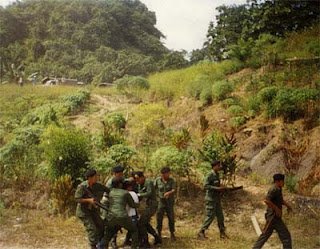Outbreak of Police Violence
by Bruno-Manser-Fonds
On December 19, 1997, a total of 22 Ibans were arrested, including a 13 year-old boy, during protests against the extension of a palmoil plantation onto land belonging to indigenous people. Two persons were badly injured by gunshots from the paramilitary police; a 40 year-old Iban died on December 24, 1997, from a gunshot in the head.
The company Empresa (M) Sdn. Bhd. already possesses several large palmoil plantations and wanted to set up a further plantation on the land of the Iban longhouse Rumah-Banggau. The people only heard of these plans when the bulldozers drove onto their land. The Iban complained to the authorities who, however, did not react. The Iban then confiscated three bulldozers and blockaded the road in front of their longhouse. The 40 policemen of the "General Operations Force" finally dispersed the group of about 60 demonstrators by force. The police wanted to arrest the chief of the longhouse. A close fight ensued during which Enyang ak Gendung, who was standing passively in the background, became mortally wounded by a shot in the head. During the shooting Indit ak Uma was also hit; wounded, he dragged himself to the longhouse and tried to defend the participants of the blockade using a bushknife. After he was hit a second time by gunshots he succeeded in wounding a policeman. He was shot a third time lying on the ground. Siba ak Sentu was also shot in the belly after he tried to protect the chief from being arrested. Other Ibans were also wounded by blows from sticks and kicks. Among them was the 63 year-old village chief Bangga Ak Andop who was arrested for several days. He was charged with carrying a weapon during a demonstration and for incitement to troublemaking. Immediately after the hearings in the court of Miri the chief was arrested a second time and jailed for ten days. The issue of the hearing concerned the charges of the Iban representatives against the company Empresa for trespassing on their land.
The Iban traditionally practice shifting cultivation (rice) and hunting and gather diverse products from the rainforest. They live in longhouses in which 20 to 30 families usually live under one roof. The Iban, as well as all the other inhabitants of Sarawak, have certain land rights which they however have to fight for in tedious court cases. These traditional land rights are being increasingly ignored by timber and plantation companies and even by the authorities. Laws were issued which increasingly restrict the indigenous peoples' entitlement to land. Compensation payments are often much too low and chiefs are being coaxed into giving up their land in exchange for money. The indigenous people of Malaysia remain a stumbling block for the gigantic development plans of the government. According to the will of the government, which aims for a maximum urbanization of 95% (!), the indigenous people should become integrated into a civilization modelled according to western criteria, allegedly to create a just society together with the membes of other races (Malays, Chinese and Tamils). In effect, "civilizing" the indigenous people can create a dependency from which they are not able to escape any more. In the end the government and private industry will gain easy access to the lands of the uprooted indigenous people. The question whether the planning of development projects in which the indigenous people present a hindrance to realization was in effect faulty from the beginning will have to be answered by Malaysia when confronted with their own conscience as well as their trading partners.
 The aborigine's graveyard
The aborigine's graveyard




No comments:
Post a Comment